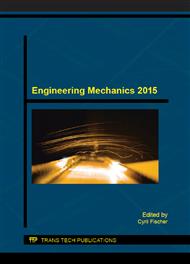p.563
p.571
p.579
p.585
p.591
p.601
p.608
p.614
p.620
Numerical Investigation of Wind Effects on the Perforated Structures
Abstract:
The paper deals with a numerical analysis of wind effects on structures with perforated surfaces. The solution based on FEM model is governed by the stabilized Navier-Stokes equations for incompressible fluid. Special attention is given to perforated surface. Such a partly resistance barrier always introduces considerable numerical difficulties resulting from the complexity of a flow distortion when the fluid is passing through. For simplification, the barrier is assumed as a thin screen with specific resistance parameters where the fluid flow mechanism needs not be resolved. The general influence of the barrier on the flow field is a loss in the normal momentum component and the change in the flow direction. On the other hand, the authentic simulation of the fluid mechanics requires specifying the relevant input parameters that can be determined by an experiment or by using a corresponding handbook.
Info:
Periodical:
Pages:
591-598
Citation:
Online since:
January 2016
Authors:
Price:
Сopyright:
© 2016 Trans Tech Publications Ltd. All Rights Reserved
Share:
Citation:


